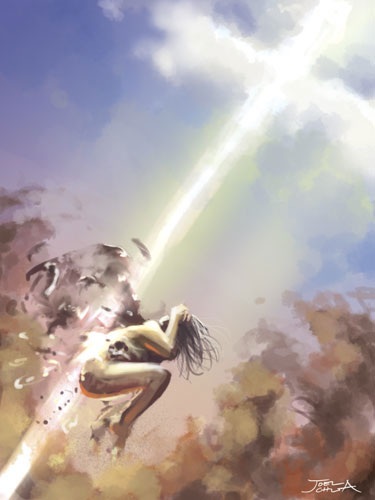Nov
20
2009
Interesting stuff from James Jordan’s Trees and Thorns: A Commentary on Genesis 2-4

.
“…swarmers-creepers are described as creatures that break the boundaries of human life and invade the human house, defiling the house.”
The first two of the four curses upon the serpent are found in Genesis 3:14. Only the serpent is directly cursed, and the word You is emphatic in Hebrew. The man and the woman are not cursed directly, but mediately through the soil, an important distinction that we shall address in due course.
Continue reading
Comments Off | tags: Genesis, Hebrew, James Jordan, serpent | posted in Biblical Theology, Quotes
Nov
1
2009

A further thought on confession related to Your Own Private Sheol:
At the seduction of Eve, Adam was faced with a creature he had previously named. This naming was the first expression of his dominion.
Continue reading
Comments Off | tags: Adam, Compromise, Confession, Genesis, Satan, serpent | posted in Biblical Theology
May
22
2009
And I looked, and behold, in the midst of the throne and of the four living creatures, and in the midst of the elders, stood a Lamb as though it had been slain, having seven horns and seven eyes, which are the seven Spirits of God sent out into all the Land. (Revelation 5:6)
The Bible is the story of the historic battle between the serpent-king and the servant king. Both sit on bloody thrones. Herod slaughters the innocents, and is then slaughtered by God. The innocent Christ is slaughtered, then sends His followers into the world as seven Spirits (Lampstand/Pentecost), but also as lambs among wolves.
Continue reading
2 comments | tags: Communion, David, Holy war, Lampstand, New Jerusalem, Revelation, serpent | posted in Biblical Theology, Christian Life, The Last Days
May
7
2009

The Nazirite Vow
(Article requested by Drew J.)
This vow in Numbers 6 follows the “inspection of jealousy” in Numbers 5. Mark Horne observed that, just as the woman in Numbers 5 was to be inspected for harlotry with her hair untamed, so the Nazirite (whether male or female) was not to cut his or her hair. A Nazirite is a human picture of the church as a warrior bride. Hair is glory. Hair is the cloud of angels (and now, saints) surrounding the throne of God.
“Therefore the woman ought to have a symbol of authority on her head, because of the angels.” (1 Cor. 11:10)
A woman is the glory of her man. A woman’s hair is a symbol of submission, but also a symbol of her own “cloud of angels” – her godly offspring (See Ezekiel 5 for the children of Israel symbolised as the prophet’s hair, Micah 1:16, Matthew 10:30 and also my comments on Nehemiah and his hair-pulling). In battle, a Nazirite was like a blazing torch (the Ark-chariot/Adam) and smoking firepot (the smoke clouds of the incense altar/Eve army), parting his enemies like the pillar of God.
The hair is her “crop”, the twelve stars around her head (Rev. 12), and the question constantly posed to Israel concerns her role as God’s mediatorial Land. Is her crop one of thorns and thistles, or is it godly grain? This is also the question in Numbers 5, and the Lord put Israel to this exact test after the idolatry with the golden calf. The “harlots” were slain with the Levitical sword.
Continue reading
3 comments | tags: Adam, David, James Jordan, John the Baptist, Judges, Nazirite, Numbers 5, Numbers 6, Obed, Paul, Revelation, Samson, Samuel, serpent, Showbread, Tabernacle, Uriah, Wisdom | posted in Against Hyperpreterism, Biblical Theology




























